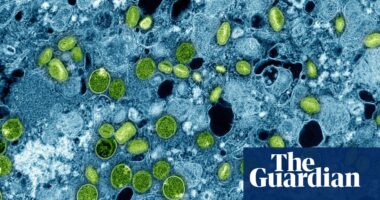Share this @internewscast.com
Necrotizing pancreatitis is a serious but uncommon complication that arises from acute pancreatitis. It initially presents as abdominal pain, but without prompt treatment, it can quickly lead to tissue damage, infections, and organ failure. The silver lining is that early diagnosis and appropriate treatment can have a significant impact. In this article, we’ll explain all the essential information you need to understand—clearly and concisely.
What is Necrotizing Pancreatitis?
Necrotizing pancreatitis, also referred to as pancreatic necrosis, is an intense form of acute pancreatitis characterized by inflammation of the pancreas coupled with tissue death in the pancreatic and adjacent areas. This condition occurs when extreme acute pancreatitis restricts blood supply to pancreatic cells, resulting in tissue death. The condition poses risks of infection, organ dysfunction, and can be fatal, making prompt identification and management vital. Research indicates that in the United States, approximately 80% of pancreatitis cases are mild, whereas severe cases constitute about 20%.
Types of Pancreatitis
- Acute pancreatitis: The common form that develops suddenly and resolves with the right treatment. It often leads to necrotizing pancreatitis.
- Chronic pancreatitis: This form lasts long and does not heal, and worsens with time, damaging the pancreas permanently. It doesn’t often lead to necrotizing pancreatitis.
What Causes Necrotizing Pancreatitis?
Necrotizing pancreatitis is caused by acute pancreatitis, which develops due to:
- Gallstones (the most common cause)
- Excessive alcohol intake
- Trauma to the pancreas
- High calcium levels
- Hypertriglyceridemia (excessive triglycerides (fats) in the blood)
- Pancreatic tumors
- Autoimmune conditions
- Genetic conditions
- Certain medications
Note: Not all acute pancreatitis cases turn into necrosis. Around 10% of individuals with acute pancreatitis develop necrotizing pancreatitis.
Symptoms of Necrotizing Pancreatitis
Initial Symptoms (similar to acute pancreatitis):
- Severe and persistent upper abdominal pain (might radiate to the back)
- Nausea and vomiting
- Abdominal bloating
Severe or Worsening Symptoms:
- Fever (particularly if infection develops)
- Faster heart rate
- Severe dehydration or thirst
- Hypotension (low blood pressure)
Complications Associated with Necrotizing Pancreatitis
If left untreated, Necrotizing Pancreatitis can lead to short-term and long-term complications:
Short-term Complications:
- Infection
- Necrotic fluid collections
- Hemorrhage (loss of blood from damaged blood vessels)
- Abdominal compartment syndrome (high pressure within the abdomen causes organ dysfunction)
Long-term Complications:
- Pancreatic insufficiency (the pancreas is unable to release adequate digestive enzymes to break down food properly)
- Disconnected pancreatic duct syndrome (the pancreatic duct that carries pancreatic secretions gets disconnected or disrupted)
- Splanchnic vein thrombosis (formation of a blood clot in one of the abdominal veins, particularly those responsible for draining blood from the digestive organs)
- Biliary stricture (a narrowing of the bile ducts, responsible for carrying bile from the liver and delivering it to the small intestine)
Pathophysiology (How Necrotizing Pancreatitis Damages Your Body)
The condition begins with the activation of digestive enzymes within the pancreas, which leads to autodigestion, where the body’s own enzymes start destroying tissues, causing inflammation and harm. In necrotizing pancreatitis, this process can result in:
- Ischemia (blockage of blood supply) to the pancreatic & peripancreatic tissues
- Infection of necrotic areas with bacteria (in some cases)
- Systemic inflammatory response syndrome (SIRS)
- Multi-organ dysfunction (in severe situations)
How Doctors Diagnose Necrotizing Pancreatitis?
The healthcare providers will first examine your symptoms and review your medical history. After the physical exam, they will order laboratory and imaging tests:
Laboratory Tests
The laboratory tests involve:
- Serum amylase and lipase test: Evaluates the levels of pancreatic enzymes such as amylase and lipase in the bloodstream.
- Elevated WBC count: Helps indicate the presence of inflammation and infection.
- Abnormal liver function tests: Find out whether necrotizing pancreatitis is gallstone-induced pancreatitis and detect biliary obstruction (blockages in the bile ducts).
- Measurement of C-reactive protein (CRP) levels: Helps detect the severity of inflammation. If levels of CRP in pancreatitis are more than 150 mg/L within 48 hours, it indicates severe acute pancreatitis. Higher than 200 to 300 mg/L shows the risk of infected necrosis.
Imaging Tests:
- Contrast-enhanced CT (CECT) Scan: The gold standard diagnostic test that identifies the necrosis (death of pancreatic tissues) and its severity.
- MRI Scan or Endoscopic Ultrasound: Helps with detailed imaging of the pancreas and nearby structures, along with the presence of dead cells.
If imaging tests show the death of some pancreatic tissues, the healthcare providers will conduct a biopsy to check for infection.
Treatment: How Is Necrotizing Pancreatitis Managed?
The treatment will depend on whether you have developed an infection or some other complications. When you develop sterile pancreatic necrosis which causes no symptoms, the doctors provide conservative treatment. On the other hand, if it’s infected pancreatic necrosis which shows signs of infection and other complications, the medical treatment is crucial.
Conservative Treatment (Non-Infected Cases)
Supportive care for sterile necrotizing pancreatitis includes:
- Pain relief: Recommends pain medicines like ibuprofen, codeine, or tramadol to relieve pain and discomfort.
- IV fluids: Give fluids intravenously to improve blood flow within the pancreas and maintain enough systemic circulation.
- Nutritional support: Involves delivering nutritious liquid food mixture directly to the digestive system via a tube, which stimulates the contractions and relaxations of intestinal muscles, supports gut barrier integrity, and reduces infection and organ failure risk.
The providers will closely monitor your health during this time. If infection or organ failure risk develops, they will provide medical treatments.
Antibiotic Treatment:
- Pancreatic infection management includes antibiotics like quinolones, metronidazole, and carbapenems in case of severe infected necrosis (indicating the presence of infection).
- These medicines penetrate the pancreatic necrotic tissue and reach the infection area to kill the bacteria effectively.
- Also, they can prevent the infection from spreading and delay or avoid medical intervention.
- However, antibiotics are not recommended for routine use to prevent infection as no evidence claims a reduction in the infection rate or mortality. Also, it may lead to resistance to infection as prolonged or unnecessary use of antibiotics leads to stronger adaptation of germs.
Surgical & Minimally Invasive Interventions
In case of severe pancreatic necrosis, the healthcare providers may order:
1. Percutaneous drainage:
- Help remove infected pancreatic necrotic tissue and fluid.
- Involves inserting a drainage tube through the skin to access the affected site, which allows delivering the saline and the drawing out the infected fluids and debris.
2. Endoscopic debridement
- This minimally invasive method aids in removing dead pancreatic tissue and preventing infection and the need for highly invasive surgery.
- Involves inserting an endoscope through the upper gastrointestinal tract to access the infected site and forming a channel between the necrotic site and the gastrointestinal tract to remove dead tissue via that channel.
3. Video-assisted retroperitoneal debridement (VARD)
- This minimally invasive approach helps get rid of infected fluid and necrotic tissue, which lowers the complications and need for open surgery.
- Involves making a small cut on the abdominal side to access the retroperitoneal space. Then, the laparoscope is inserted to access the necrotic tissue and remove it, and the area is thoroughly cleaned to alleviate debris and infection.
4. Open surgery (necrosectomy)
- Recommended to treat severe cases like infected necrosis tissue to prevent the spread of infection and prevent further complications like rupture in the gastrointestinal tract or hemorrhage.
- During the open necrosectomy, the surgeons cut the abdomen to access the necrotic tissue, which is then removed with the help of suction and blunt dissection to prevent damage to crucial nearby structures.
Can Necrotizing Pancreatitis Be Prevented?
No, it can’t be completely prevented. However, with these lifestyle changes, you can reduce the risk and stay healthy:
- Avoid excessive consumption of alcohol.
- Do not smoke.
- Maintain a healthy body weight.
- Avoid a crash diet.
- Do not skip meals.
If you experience any symptoms of acute pancreatitis, see a doctor to prevent the progression of the condition.
Prognosis: What to Expect
The prognosis or prediction depends on the severity of necrotizing pancreatitis, the presence of infection or risk of organ failure, and the timing and response to the treatment.
- If necrotizing pancreatitis impacts less than 30% of the pancreas, mortality (death), organ failure, and infection rates are under 20%.
- If it affects over 50% of the pancreas, the rate of mortality is 40%, multi-organ dysfunction is 65%, and infection is 50%.
- Getting the appropriate diagnosis and treatment is the right way to reduce further complications.
Final Thoughts
Necrotizing pancreatitis is a severe and life-threatening condition that needs early diagnosis and treatment. While some individuals with acute pancreatitis require only supportive care, others with severe pancreatitis may need intensive care, like antibiotics and surgical procedures. Seeking timely care and treatment can improve health outcomes.
So, if you experience any severe symptoms, report them to your doctor. Early diagnosis and treatment can save many lives.
FAQs
When does pancreatitis become fatal?
When pancreatitis progresses to a severe form, it becomes fatal, causing complications such as infection, organ failure, and pancreatic necrosis.
What is the diet for acute necrotizing pancreatitis?
The diet involves foods rich in high protein and low fat. Initially, you need to have clear liquids like broth or gelatin, and then slowly consume more solid foods.
What is the timeline of necrotizing pancreatitis?
It develops within 48 to 72 hours of the beginning of acute pancreatitis with visible signs that appear in around 3-5 days. However, it can sometimes occur soon.
Can you fully recover from necrotizing pancreatitis?
Yes, with timely and proper treatment, you can recover fully. However, some people experience recurrence or persistent issues that may need close monitoring.
How long is the hospital stay for necrotizing pancreatitis?
It’s typically a few days or several months. The timing can vary based on the severity of the necrotizing pancreatitis and the need for more monitoring or treatment. Severe cases need longer stays.











